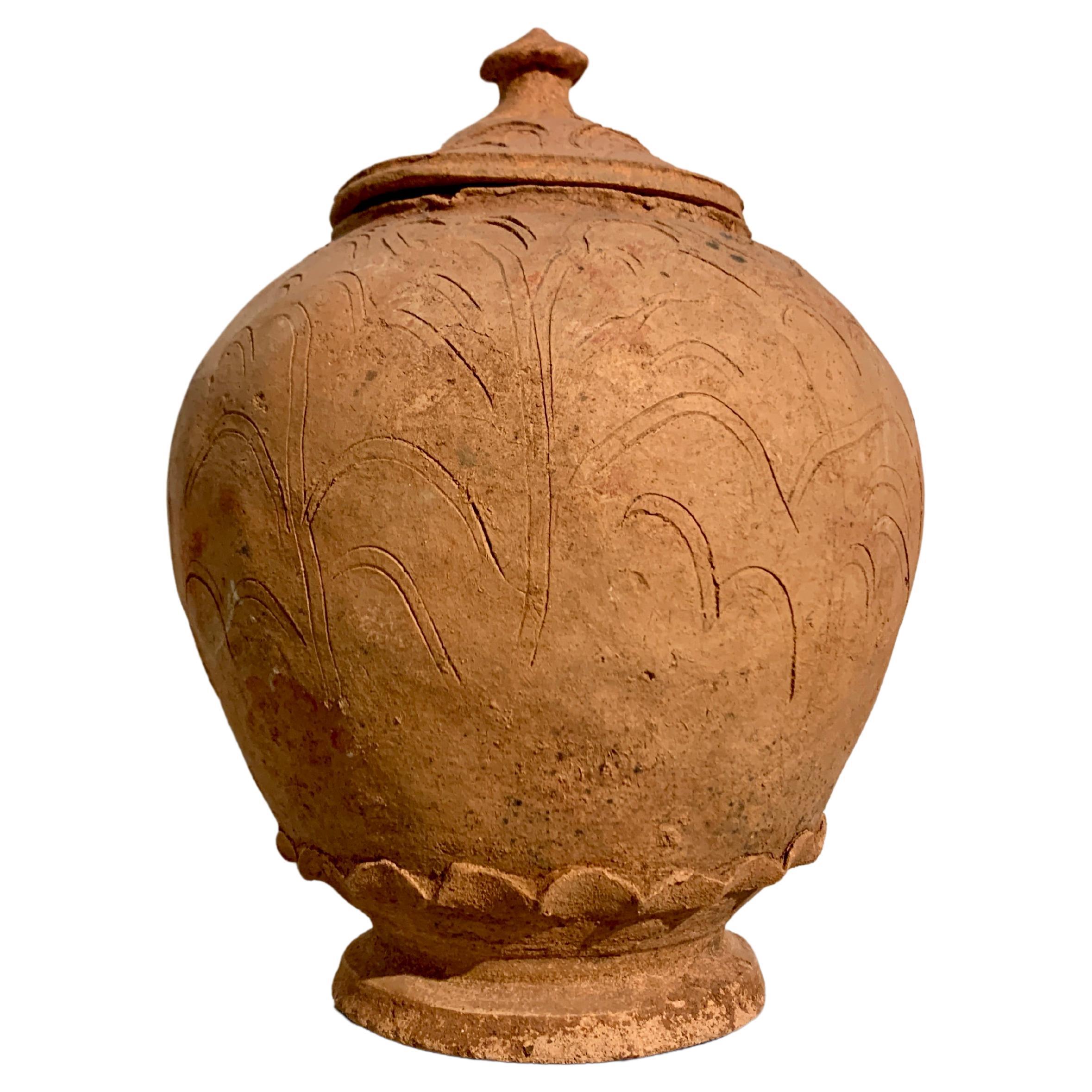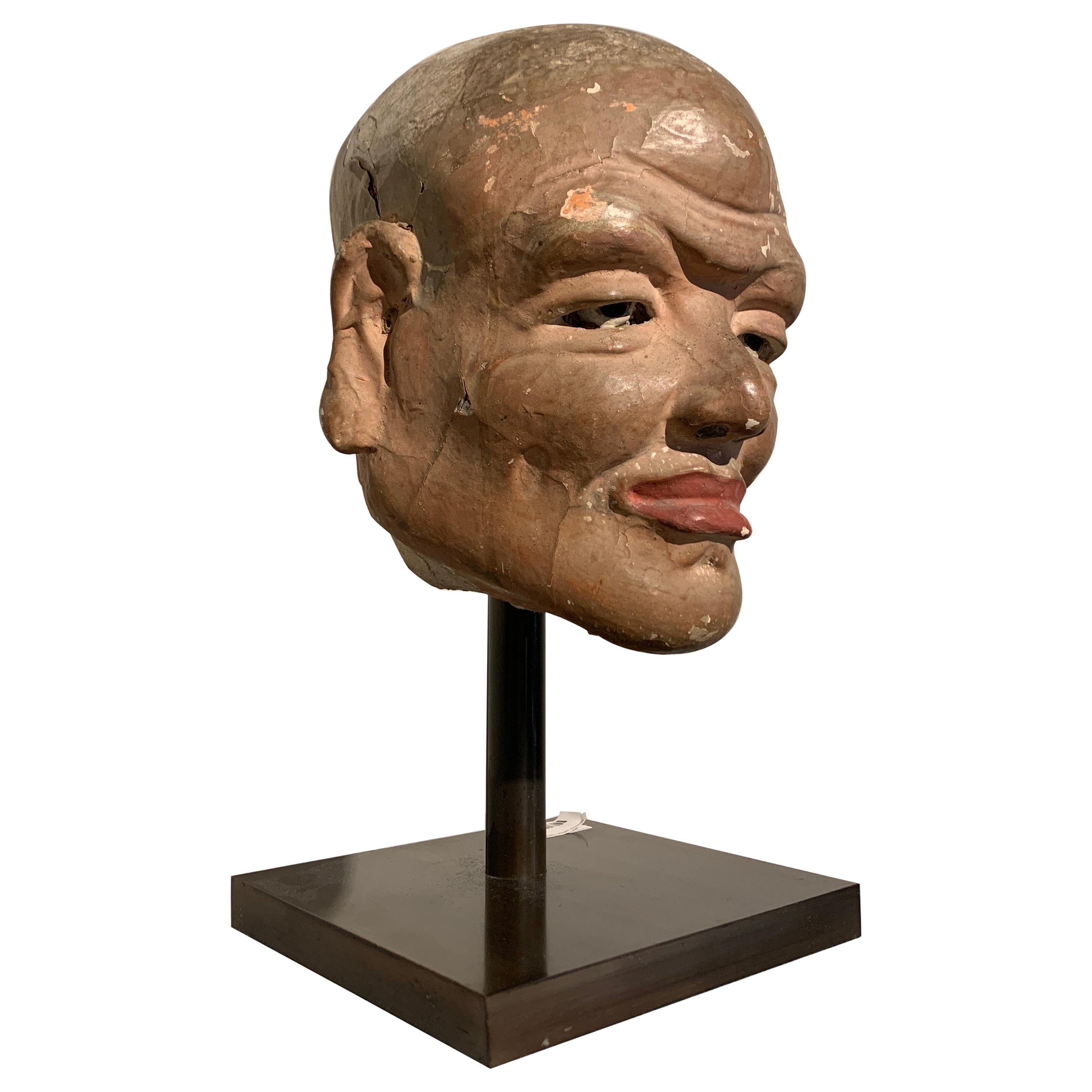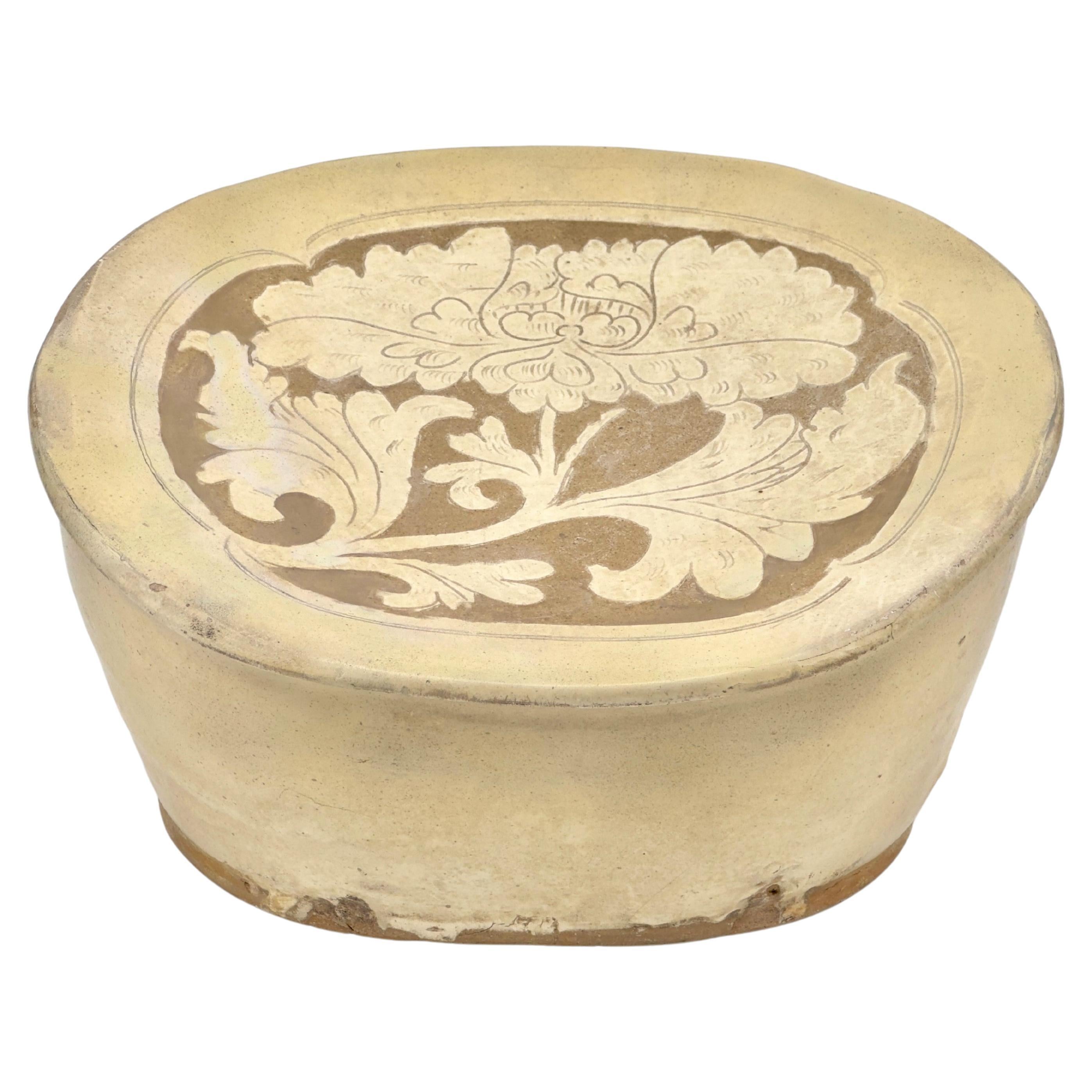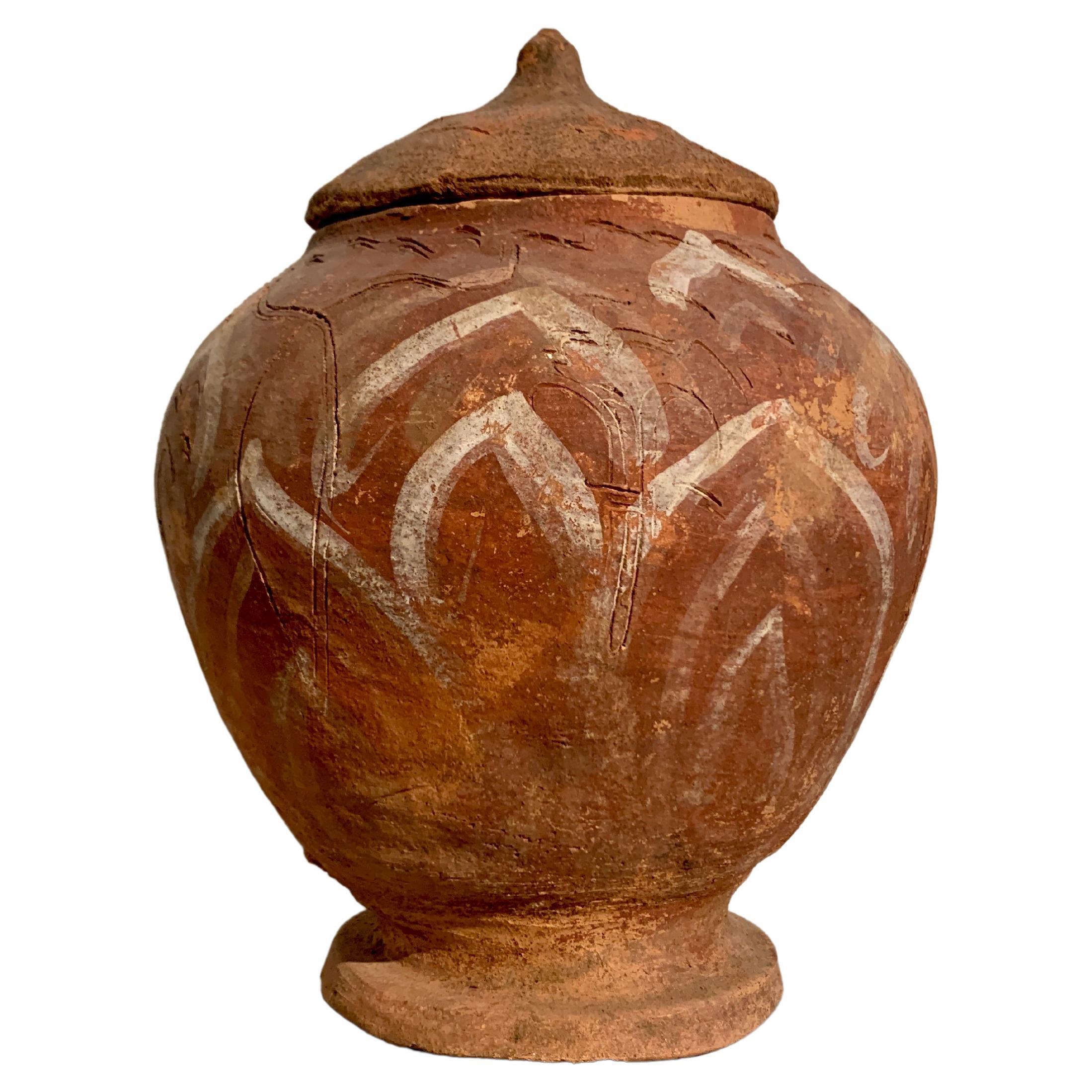Items Similar to Celadon Vase, Five Dynasties or Northern Song dynasty, 10th-11th Century
Want more images or videos?
Request additional images or videos from the seller
1 of 10
Celadon Vase, Five Dynasties or Northern Song dynasty, 10th-11th Century
About the Item
The form of Longquan celadon vases from the Northern Song dynasty evolved from an early design with a long neck and tapering body to a later ovoid body with a shorter neck. Over time, the glaze developed a more olive tone, and the carved decorations became more pronounced and intricate. Examples of such vases include one without a cover dated to the Yuanfeng era (1078~1085) and documented in literature, and another similar vase without loop handles preserved by the Qingyuan County Cultural Relics Bureau. An earlier example featuring loop handles and a lotus-like cover is also mentioned in historical texts.
The use of Longquan covered vases, especially as funerary jars for offerings like wine and grains, was highlighted by an inscription on a piece from the Sir Percival David Collection, London. This inscription wishes for the vessel to preserve fragrant wine for centuries, blessing the owner with prosperity, longevity, and a vast lineage, dated to the third year of the Yuanfeng period (1080). This practice was common in the regions of Southern Zhejiang and Northern Fujian. A similar celadon vase from the Linyushanren collection was auctioned at Christie’s Hong Kong, emphasizing the cultural and historical significance of these artifacts.
Period : Five Dynasties or Northern Song Dynasty
Type : Celadon, Zhejiang province
Medium : Celadon
Size : 31.5 cm(Height) x 11.5(Diameter)
Provenance : Acquired in late 1990s from Hongkong
Reference :
1) The British Museum image id - 01613270570
2) Christies New York 23–24 MAR 2023 - Important Chinese Ceramics and Works of Art - Lot 1012
(Price Range : USD 18,000 – USD 25,000 / Type : Related)
3) National Gallery of Victoria - Accession Number - AS5-1973
* Celadon from Five Dynasties (907~960) to the early Northern Song Dynasty (960~1127)
The period from the Five Dynasties (907~960) to the early Northern Song Dynasty (960~1127) marked a significant transitional phase in the development of Chinese celadon ceramics. During this era, celadon underwent considerable advancements both technically and artistically, securing its place as one of the most important genres of ancient Chinese pottery.
Technical Advancements
- Glaze Innovation: There was a notable evolution in celadon glaze technology during this period. The glazes became richer and more varied in color, ranging from celadon's signature bluish-green to olive green tones. - High-Temperature Firing: Improvements in firing techniques at high temperatures enhanced the quality of the products. This allowed the glaze to bond better with the body, resulting in a more durable and lustrous surface.
Artistic Development
- Forms and Design: Early celadon pieces evolved from simple shapes to more complex and refined designs. A variety of items, including vases, jars, and bowls, were produced, with surface decorations becoming increasingly diverse.
- Carved Decorations: This period saw the addition of carved decorations on celadon wares, featuring motifs of plants, animals, and geometric patterns. These decorations further accentuated the beauty of celadon ceramics.
Regional Characteristics
- Importance of Location: The main production area for celadon during this era was the Longquan region in Zhejiang Province. Longquan celadon became renowned for its distinctive color and quality, exerting a significant influence on later generations.
Cultural Impact
- Popularity at Home and Abroad: Early celadon was highly popular not only within China but also internationally. It was exported to Southeast Asia, the Middle East, and even Africa.
- Symbol of Social Status: High-quality celadon was favored among the nobility and upper classes, serving as a symbol of social status during this time.
These advancements during the transition from the Five Dynasties to the early Northern Song Dynasty played a crucial role in establishing Chinese celadon as one of the world-renowned categories of ceramics.
- Dimensions:Height: 12.41 in (31.5 cm)Diameter: 4.53 in (11.5 cm)
- Style:Ming (Of the Period)
- Materials and Techniques:
- Place of Origin:
- Period:
- Date of Manufacture:10th-11th Century
- Condition:Wear consistent with age and use.
- Seller Location:seoul, KR
- Reference Number:1stDibs: LU9577238562092
About the Seller
New to 1stDibs
Joined in the past six months.
4.5
Vetted Seller
These experienced sellers undergo a comprehensive evaluation by our team of in-house experts.
Established in 1999
1stDibs seller since 2023
Typical response time: 1 hour
- ShippingRetrieving quote...Ships From: seoul, Korea South
- Return PolicyA return for this item may be initiated within 10 days of delivery.
More From This SellerView All
- Longquan Celadon Five-Spouted Jar, Northern Song Dynasty (AD 960~1127)Located in seoul, KRThickly potted with an ovoid body of five horizontal lobes tapering toward the top, carries both aesthetic and practical values. The jar is intricately carved with rows of upright lo...Category
Antique 15th Century and Earlier Chinese Ming Antiquities
MaterialsCeladon
- Small Celadon Chrysanthemum Dish, Northern Song Dynasty(AD 960~1127)Located in seoul, KRPotted with the fluted sides rising from a recessed base, carved to the interior with Chrysanthemum, covered overall with a grayish-green glaze, save for a ring to the underside left...Category
Antique 15th Century and Earlier Chinese Ming Antiquities
MaterialsCeladon
- Cizhou carved bean-shaped pillow, Song-Jin Dynasty, 11th-12th centuryLocated in seoul, KRCrafted from fine clay, the pillow's surface boasts a sophisticated carved design featuring a floral motif that is both symmetrical and organic. The interplay of the earthy tones and...Category
Antique 15th Century and Earlier Chinese Chinoiserie Antiquities
MaterialsStoneware
- Carved 'Yaozhou' Celadon-Glazed Bowl, Song DynastyLocated in seoul, KRThe bowl is potted with steep, flared sides and decorated to the interior with stylized peonies among scrolling tendrils. The exterior is carved with vertical lines below the everted...Category
Antique 15th Century and Earlier Chinese Ming Antiquities
MaterialsCeladon
- A Rare Dingyao Green-Glazed Dragon Dish, Northern Song DynastyLocated in seoul, KRThis green-glazed bowl was finely crafted with an attention to detail that highlights the skill of the Cizhou green and Ding ware potter. Its delicate form has been adorned with a dr...Category
Antique 15th Century and Earlier Chinese Ming Antiquities
MaterialsCeramic, Stoneware
- Longquan Celadon 'Dragon' Jar and Cover, Southern Song Dynasty(1127–1279)Located in seoul, KRA similar jar with a cover, part of the Avery Brundage collection at the Asian Art Museum in San Francisco, is featured in Mary Tregear's "Song Ceramics" (London, 1982, plate 286). T...Category
Antique 15th Century and Earlier Chinese Ming Antiquities
MaterialsCeladon
You May Also Like
- Chinese Pottery Lotus Jar, Five Dynasties, 10th century, ChinaLocated in Austin, TXA stately Chinese molded, carved, and painted "lotus jar", Five Dynasties and Ten Kingdoms (907 - 979 AD), Dali Kingdom, China. The elegant vessel of fir...Category
Antique 15th Century and Earlier Chinese Antiquities
MaterialsPottery
- Chinese Painted Stucco Head of a Luohan, Song Dynasty, 11th Century, ChinaLocated in Austin, TXA remarkable Chinese life sized painted stucco head of a luohan, Song, Liao or Jin Dynasty, circa 11th century, China. The amazingly life-like figure depicts a luohan (sometime spelled lohan), also known as an arhat, one of the original disciples of the Buddha. The elderly man has been molded in stucco with inset glass eyes and painted with idealized, if slightly exaggerated features. The unidentified luohan sports a bald, or perhaps shaved, domed head above a bulging forehead, symbolizing his vast wisdom. The wrinkles in his furrowed brow, and creases around his eyes add to his realism. The learned man stares out wisely from deep set, heavily lidded inlaid glass eyes that catch the light. The luohan has high cheekbones and a prominent jawline. His lips full and pursed as if about to speak. The corners of his mouth turned up ever so slightly in a faint smile, causing his gaunt cheeks to dimple charismatically. A series of dots above the upper lip indicate he may originally have sported a mustache of real hair. This life sized head with extremely realistic features fits into a very narrow time frame of Chinese Buddhist art. Perhaps the most recognized group of large, finely molded Chinese luohan...Category
Antique 15th Century and Earlier Chinese Sculptures and Carvings
MaterialsGlass, Stucco
- Chinese Red Pottery Lotus Jar, Five Dynasties, 10th Century, ChinaLocated in Austin, TXA boldly painted Chinese pottery "lotus jar" with incised decoration, Five Dynasties and Ten Kingdoms, Dali Kingdom, 10th century, Yunnan, China. The ele...Category
Antique 15th Century and Earlier Chinese Antiquities
MaterialsPottery
- Korean Bronze Bottle Vase, Goryeo Dynasty, 11th/12th Century, KoreaLocated in Austin, TXAn attractive Korean Goryeo Dynasty bronze bottle vase with traces of gilding, 11th - 12th century, Korea. The vase of typical form, with a short recessed foot supporting a pear s...Category
Antique 15th Century and Earlier Korean Metalwork
MaterialsBronze
- Chinese Liao Dynasty Amber Glazed Stoneware Strap Handle Ewer, 11th CenturyLocated in Austin, TXA lovely Chinese amber glazed pottery pouring vessel, Liao Dynasty (907 to 1125 AD). The vessel featuring a globular body with an elongated neck sligh...Category
Antique 15th Century and Earlier Chinese Tang Ceramics
MaterialsStoneware
- Chinese Yueyao Celadon Glazed Jar 'Guan', Five Dynasties, 10th CenturyLocated in Austin, TXA sublime Chinese Yueyao glazed guan jar with incised decoration and applied handles, five dynasties period (907- 979 AD), China. The vessel of somewhat flattened globular form, w...Category
Antique 15th Century and Earlier Chinese Tang Ceramics
MaterialsStoneware
Recently Viewed
View AllMore Ways To Browse
Chinese Export Bureau
Venini Mid Century
Table Mirror Italy
Murano Space
Modern Metal Showcase
Mid Century Brown Pottery
Japanese Glaze
Mid Century Chandelier Aluminum
Chairs French 1950
Dining Table Set With Silver
Antique Religious Silver
Pendant Chandelier White Vintage
Aluminum Ceiling Light
Antique Art Deco Poster
6 Light Chandelier Glass
Small White Lighting Pendant
Italian Sofa Armchairs
End And Accent Tables





